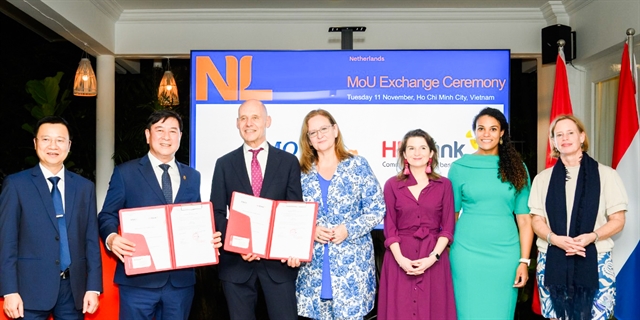 Opinion
Opinion

There remains room for further improvement in the quality of higher education and the provision of a sufficient high-quality workforce.

|
| Dr Nguyễn Thu Thủy, head of the Ministry of Education and Training’s Department of Higher Education. VNA/VNS Photo |
After a decade of reforms, higher education has witnessed significant enhancements, effectively fulfilling the need for high-quality human resources. Nevertheless, there remains room for improvement in the quality of higher education and the provision of a sufficient high-quality workforce. Dr Nguyễn Thu Thủy, head of the Ministry of Education and Training’s Department of Higher Education shared her insights on this matter with the Vietnam News Agency.
What are the achievements of higher education in recent years?
I believe that the most crucial factor is the development of the faculty. This is the decisive element in determining the quality of education and the overall progress of the entire system. Over the past ten years, the number of university lecturers has increased significantly. The proportion of lecturers holding a PhD degree has risen from less than 15 per cent to over 32 per cent. The number of scientific publications per lecturer, as well as the overall quantity of publications, has yielded remarkable results. The number of international and domestic scientific publications and intellectual property assets has steadily increased over the years. Many research results and products of scientific value, technological processes with high applicability and commercial potential, have made significant contributions to the country's economic and social development.
Higher education institutions have made every effort to diversify their training programmes, teaching methods, renovate and upgrade infrastructure and learning and research environments, and provide modern, internationally integrated student support services. The number of higher education institutions, as well as the number of internationally accredited programmes is on the rise.
Admission policies and regulations for university entrance have been reformed to ensure the best interests of the candidates. Higher education institutions are empowered to select their admission methods, and the admission process occurs multiple times throughout the year.
Although the quality assurance and accreditation system for higher education in Việt Nam is relatively new, it has made steady progress, meeting the needs for quality assurance of educational institutions and programs at all levels of higher education.
Universities independently develop their programmes based on national higher education standards for each academic program, including intellectual capacity development, ethics, and skills aligned with the National Framework of Qualifications and the National Qualification Framework of Việt Nam.
The number of new training programmes offered by higher education institutions in recent years has increased significantly, meeting the requirements of the labour market.
In particular, the internationalisation of higher education in Việt Nam has also expanded considerably, with effective cooperation in research, training, and faculty and student exchange within an international context. Institutions continuously update their curricula, technologies, and teaching methods, staying current with the latest global developments.
Considering the limited resources invested in Vietnamese higher education over the past few decades, with relatively low levels of funding compared to the region and the world, these achievements are evaluated as highly efficient and deserving of recognition.
The 13th Party Congress acknowledged the challenge of inadequate high-quality workforce training. What are the reasons for this?
In reality, not only Việt Nam but many countries worldwide are currently grappling with a significant challenges of a shortage of highly skilled and specialised labour. While the quality of higher education in Việt Nam has seen considerable improvements, there remains a notable gap compared to developed nations and between various universities. The academic programmes and fields of study have not fully met the socio-economic development requirements.
The labour market faces a shortage of high-quality workforce, particularly in some scientific, technical and technological fields, while a significant proportion of graduates lack the necessary job skills, making it difficult for them to find suitable employment opportunities.
Over the past ten years, the number of universities and students in the country has increased significantly, but the proportion of students pursuing higher education remains low compared to advanced countries. Additionally, there is a significant disparity in access to higher education between different regions and localities.
The primary reasons for these limitations are the very low level of investment in higher education and the lack of effective financial policies. Despite the universities' efforts to promote service activities and seek alternative funding sources, their main source of revenue still comes from tuition fees.
In recent times, the push for financial autonomy in public universities has been associated with regular budget cuts from the State budget, while the decentralisation of new educational programmes has been implemented on a limited scale, primarily focusing on teacher training programmes. This has led most universities to seek to optimise their operations by expanding fields of study that are financially profitable. Some key fields, especially in science, technology, agriculture, and aquaculture, have had difficulty attracting students, especially at the postgraduate level.
Additionally, due to the limited scope of implemented student support policies, the cost of education remains a barrier for many students, particularly those from poor families.
What measures has the ministry taken to tackle this and what steps are necessary to enhance higher education in the future?
The ministry has been building a development strategy for education for the period of 2021-2030 with a vision towards 2045. In this strategy, autonomy for universities and digital transformation are the two strategic breakthroughs to promote the training of high-quality and highly skilled human resources.
The ministry has been implementing the development of a network of higher education institutions and teacher training institutions for the period of 2021-2030 with a vision towards 2050, in accordance with the provisions of the Planning Law.
We have been accelerating the implementation of the Vietnamese Qualifications Framework, developing and applying high-standard training programmes, particularly for fields of science, technology, and engineering. This involves maintaining high-level programme standards equivalent to regional and global standards.
The ministry has also focused on enhancing the capacity of teaching staff and administrative personnel and attracting talent, investing in innovation and scientific and technological development, technology transfer, and research orientation at higher education institutions.
Policies and mechanisms to encourage universities' academic autonomy has been established. Many technical and economic universities have started offering new programmes such as artificial intelligence, robotics, data science, Fintech, and more.
At the same time, the quality of foreign language teaching and learning at all levels of education has been improved.
The ministry is coordinating with relevant ministries, departments, and agencies to conduct research and develop initiatives to cultivate high-quality human resources to serve high technology development. This includes the experimental implementation of digital university education models, the establishment of excellent research and training centres. These initiatives are expected to be presented to the Prime Minister in the fourth quarter of 2023.
These initiatives will create a breakthrough in the training of high-quality human resources in the near future. The initiative to develop high-quality human resources for high technology development will propose solutions such as financial support policies for learners, the implementation of mechanisms for ordering and training high technology personnel, encouraging business involvement in training high technology personnel, supporting employment for graduates, enhancing teaching and research capabilities for higher education institutions.
Additionally, the ministry is actively planning to expedite high-quality human resources training in the semiconductor and microchip sector.
In the coming time, higher education needs to mobilise sufficient resources for new development phases. We urgently require guidance in the form of investments from the State budget. There needs to be a roadmap for increasing State budget allocations to a level equivalent to countries with advanced higher education systems in the region and the world. Simultaneously, we must improve policies to encourage private sector investment. The focus should be on comprehensive technical infrastructure development for higher education institutions, especially national key higher education institutions that play a leading role in the system.
A substantial overhaul of financial mechanisms for higher education is necessary. State budget allocation should be based on capabilities and effectiveness, promoting privatisation to encourage business collaboration in education and scientific research with higher education institutions.
The entire higher education system should concentrate on driving digital transformation in higher education, and enhancing the transparency, flexibility, efficiency, and cost-effectiveness of higher education systems.
Strengthen quality assessment and monitoring of higher education is also needed to be done. With the widespread adoption of university autonomy, the assessment and accreditation mechanisms play a critical role in monitoring and enhancing the quality of higher education. The standards and processes for evaluating and accrediting training programs and institutions, both domestically and internationally, should adopt a systemic approach. This involves measuring and evaluating not only the programme's outcomes but also all inputs, internal elements, and quality management systems. – VNS




